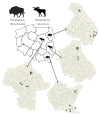Prevalence and Genotyping of Anaplasma phagocytophilum Strains from Wild Animals, European Bison (Bison bonasus) and Eurasian Moose (Alces alces) in Poland
- PMID: 35565648
- PMCID: PMC9105415
- DOI: 10.3390/ani12091222
Prevalence and Genotyping of Anaplasma phagocytophilum Strains from Wild Animals, European Bison (Bison bonasus) and Eurasian Moose (Alces alces) in Poland
Abstract
Wild large ungulates, like European bison (Bison bonasus) and Eurasian moose (Alces alces), form an important part of the circulation of Anaplasma phagocytophilum, a Gram-negative, intracellular, tick-transmitted bacterium, in the natural environment. Bison and moose tissue samples were subjected to 16S rDNA, groEL and ankA partial gene marker amplification with specific primers using various variants of PCR. Out of 42 examined individuals, Anaplasma sp. were detected in 4/13 Eurasian moose (31%) and 7/29 European bison (24%). In addition, 12 groEL and 5 ankA partial gene positive samples were obtained from the examined animals. The phylogenetic analysis of the groEL partial gene classified samples from European bison to ecotype I, and samples from Eurasian moose to ecotype I and II; the analysis of the ankA partial gene assigned the samples to clusters I and IV. This study extends knowledge about A. phagocytophilum in wild large ungulates in Poland. This is the first report about the occurrence of Anaplasma sp. in one of the largest populations of free living European bison in the world. Our findings confirm that strains of A. phagocytophilum from Bison bonasus and Alces alces may constitute a natural reservoir of pathogenic HGA Anaplasma strains.
Keywords: 16S rDNA; Alces alces; Anaplasma phagocytophilum; Bison bonasus; ankA; groEL.
Conflict of interest statement
The authors declare no conflict of interest.
Figures



Similar articles
-
Diversity of Anaplasma phagocytophilum Strains from Roe Deer (Capreolus capreolus) and Red Deer (Cervus elaphus) in Poland.Animals (Basel). 2024 Feb 16;14(4):637. doi: 10.3390/ani14040637. Animals (Basel). 2024. PMID: 38396605 Free PMC article.
-
The infection of reintroduced ruminants - Bison bonasus and Alces alces - with Anaplasma phagocytophilum in northern Poland.Acta Parasitol. 2015 Dec;60(4):645-8. doi: 10.1515/ap-2015-0091. Acta Parasitol. 2015. PMID: 26408585
-
Anaplasma phagocytophilum in European bison (Bison bonasus) and their ticks from Lithuania and Poland.Ticks Tick Borne Dis. 2023 Nov;14(6):102246. doi: 10.1016/j.ttbdis.2023.102246. Epub 2023 Aug 26. Ticks Tick Borne Dis. 2023. PMID: 37639831
-
The Occurrence of Zoonotic Anaplasma phagocytophilum Strains, in the Spleen and Liver of Wild Boars from North-West and Central Parts of Poland.Acta Parasitol. 2021 Sep;66(3):1082-1085. doi: 10.1007/s11686-021-00368-6. Epub 2021 Mar 26. Acta Parasitol. 2021. PMID: 33770340 Free PMC article.
-
Anaplasma phagocytophilum infection in moose (Alces alces) in Norway.Microbes Infect. 2015 Nov-Dec;17(11-12):823-8. doi: 10.1016/j.micinf.2015.09.013. Epub 2015 Sep 30. Microbes Infect. 2015. PMID: 26428857
Cited by
-
Diversity of Anaplasma phagocytophilum Strains from Roe Deer (Capreolus capreolus) and Red Deer (Cervus elaphus) in Poland.Animals (Basel). 2024 Feb 16;14(4):637. doi: 10.3390/ani14040637. Animals (Basel). 2024. PMID: 38396605 Free PMC article.
-
Tick-Borne Bacterial Diseases in Europe: Threats to public health.Eur J Clin Microbiol Infect Dis. 2024 Jul;43(7):1261-1295. doi: 10.1007/s10096-024-04836-5. Epub 2024 Apr 27. Eur J Clin Microbiol Infect Dis. 2024. PMID: 38676855 Review.
-
Arthropod-borne pathogens in European bison Bison bonasus (Linnaeus, 1758).Int J Parasitol Parasites Wildl. 2025 Jul 4;27:101110. doi: 10.1016/j.ijppaw.2025.101110. eCollection 2025 Aug. Int J Parasitol Parasites Wildl. 2025. PMID: 40688179 Free PMC article.
-
First Molecular Detection of Bartonella bovis and Bartonella schoenbuchensis in European Bison (Bison bonasus).Animals (Basel). 2022 Dec 28;13(1):121. doi: 10.3390/ani13010121. Animals (Basel). 2022. PMID: 36611730 Free PMC article.
-
Presence of Anaplasma phagocytophilum Ecotype I in UK Ruminants and Associated Zoonotic Risk.Pathogens. 2023 Jan 30;12(2):216. doi: 10.3390/pathogens12020216. Pathogens. 2023. PMID: 36839488 Free PMC article.
References
-
- Scharf W., Schauer S., Freyburger F., Petrovec M., Schaarschmidt-Kiener D., Liebisch G., Runge M., Ganter M., Kehl A., Dumler J.S., et al. Distinct host species correlate with Anaplasma phagocytophilum ankA gene clusters. J. Clin. Microbiol. 2011;49:790–796. doi: 10.1128/JCM.02051-10. - DOI - PMC - PubMed
-
- Gordon W.S., Brownlee A., Wilson D.R., MacLeod J. Tick-borne fever (a hitherto undescribed disease of sheep) J. Comp. Pathol. 1932;45:301–307. doi: 10.1016/S0368-1742(32)80025-1. - DOI
-
- Dumler J.S., Barbet A.F., Bekker C.P., Dasch G.A., Palmer G.H., Ray S.C., Rikihisa Y., Rurangirwa F.R. Reorganization of genera in the families Rickettsiaceae and Anaplasmataceae in the order Rickettsiales: Unification of some species of Ehrlichia with Anaplasma, Cowdria with Ehrlichia and Ehrlichia with Neorickettsia, descriptions of six new species combinations and designation of Ehrlichia equi and ‘HGE agent’ as subjective synonyms of Ehrlichia phagocytophila. Pt 6Int. J. Syst. Evol. Microbiol. 2001;51:2145–2165. doi: 10.1099/00207713-51-6-2145. - DOI - PubMed
-
- Dzięgiel B., Adaszek Ł., Krzysiak M., Skrzypczak M., Adaszek M., Furmaga B., Winiarczyk S. The occurrence of Anaplasma phagocytophilum in wild bison from the Bialowieza Primeval Forest in Eastern Poland. Berl. Munch. Tierarztl. Wochenschr. 2015;128:310–314. - PubMed
LinkOut - more resources
Full Text Sources
Research Materials

